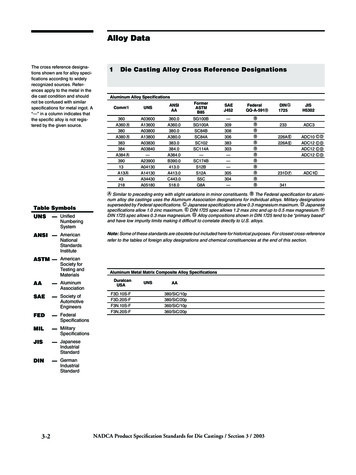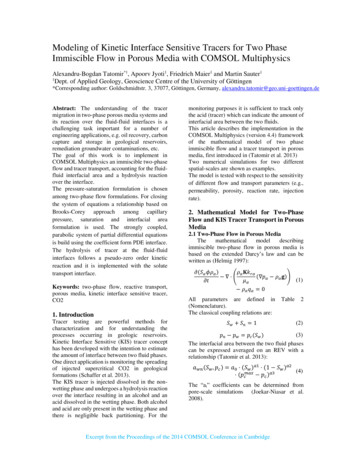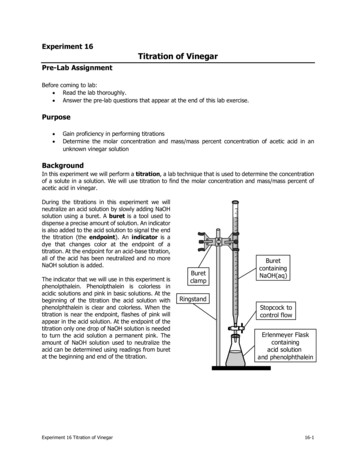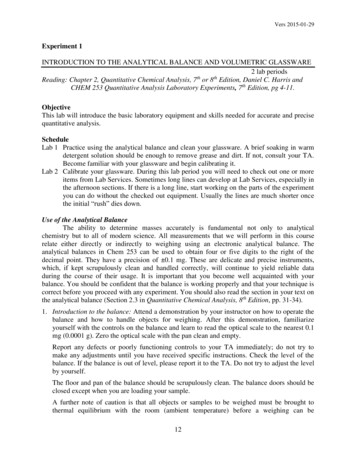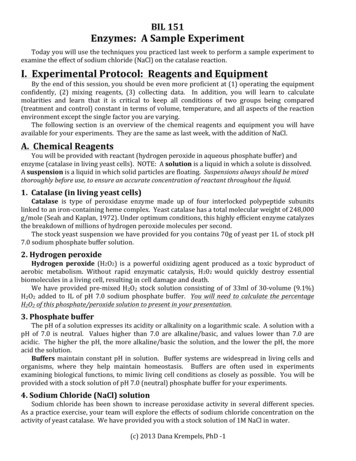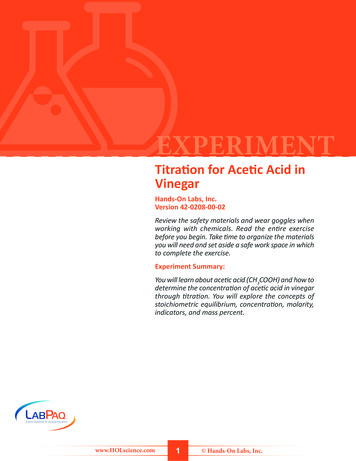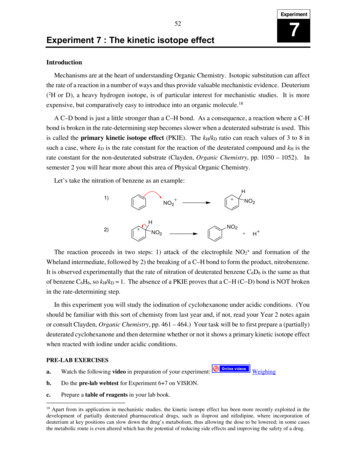
Transcription
Experiment527Experiment 7 : The kinetic isotope effectIntroductionMechanisms are at the heart of understanding Organic Chemistry. Isotopic substitution can affectthe rate of a reaction in a number of ways and thus provide valuable mechanistic evidence. Deuterium(2H or D), a heavy hydrogen isotope, is of particular interest for mechanistic studies. It is moreexpensive, but comparatively easy to introduce into an organic molecule.18A C–D bond is just a little stronger than a C–H bond. As a consequence, a reaction where a C-Hbond is broken in the rate-determining step becomes slower when a deuterated substrate is used. Thisis called the primary kinetic isotope effect (PKIE). The kH/kD ratio can reach values of 3 to 8 insuch a case, where kD is the rate constant for the reaction of the deuterated compound and kH is therate constant for the non-deuterated substrate (Clayden, Organic Chemistry, pp. 1050 – 1052). Insemester 2 you will hear more about this area of Physical Organic Chemistry.Let’s take the nitration of benzene as an example:H1)NO2NO2H2)NO2NO2HThe reaction proceeds in two steps: 1) attack of the electrophile NO2 and formation of theWheland intermediate, followed by 2) the breaking of a C–H bond to form the product, nitrobenzene.It is observed experimentally that the rate of nitration of deuterated benzene C6D6 is the same as thatof benzene C6H6, so kH/kD 1. The absence of a PKIE proves that a C H (C D) bond is NOT brokenin the rate-determining step.In this experiment you will study the iodination of cyclohexanone under acidic conditions. (Youshould be familiar with this sort of chemisty from last year and, if not, read your Year 2 notes againor consult Clayden, Organic Chemistry, pp. 461 – 464.) Your task will be to first prepare a (partially)deuterated cyclohexanone and then determine whether or not it shows a primary kinetic isotope effectwhen reacted with iodine under acidic conditions.PRE-LAB EXERCISESa.Watch the following video in preparation of your experiment:b.Do the pre-lab webtest for Experiment 6 7 on VISION.c.Prepare a table of reagents in your lab book.18WeighingApart from its application in mechanistic studies, the kinetic isotope effect has been more recently exploited in thedevelopment of partially deuterated pharmaceutical drugs, such as iloprost and nifedipine, where incorporation ofdeuterium at key positions can slow down the drug’s metabolism, thus allowing the dose to be lowered; in some casesthe metabolic route is even altered which has the potential of reducing side effects and improving the safety of a drug.
537ADeuteration of cyclohexanoneSafety NotesCyclohexanone reaction product:Flammable liquid and vapour; harmful if inhaled.Deuterium oxide, magnesium sulfate: Treat as harmful.Potassium carbonate:Harmful if swallowed; causes skin irritation and serious eye irritation; may causerespiratory irritation.Iodine:Harmful in contact with skin; harmful if inhaled; very toxic to aquatic life.Hydrochloric acid:Causes skin burns; may cause respiratory irritation.ProcedureOD2OK2CO3I27AHCl7BC6 H10O(98.14)Note: Part A of this experiment is not very time-consuming but will require 2 lab sessions andsome planning ahead. You should start with this experiment no later than week 5.Add cyclohexanone (1 g), D2O (2 mL) and anhydrous potassium carbonate (0.1 g) to a smallglass vial, close it tightly and leave to react at 80 C for 3 – 4 days until the next lab sessionusing the hotplate/sand bath dedicated for this experiment in one of the fume cupboards.MgSO4Work-up: remove the organic layer with a pipette. Make sure it contains as little water asCottonwoolpossible. If necessary, wash with a small amount of brine. Store your deuterated product ina tightly closed plastic vial.Record an IR spectrum of your product.19 Prepare a sample for 1H NMR analysis, followingthe instructions in Appendix 2. Dissolve one drop (ca. 20 mg) of your product in 0.8 mL ofCDCl3, then filter through a pipette containing a small piece of glass wool and a small amountof MgSO4 (see diagram on the left). The filtrate must be clear and should not contain anywater. The fill height must still be 5 cm. Ask a demonstrator to run your sample on the 300MHz NMR spectrometer. Feel free to join the demonstrator when he/she is doing this. Don’tforget to clean the NMR tube. Wash the NMR tube with acetone and return it to Brian.19The IR frequency ν of a bond depends on the force constant k and the reduced mass µ of the atoms at both ends of thebond: ν 1 k . The force constant for a C–H and a C–D bond are about the same, but the reduced masses differ a2πc µlot. Where would you expect to find the C-D stretch?
54Results & DiscussionAnalyse the spectroscopic data of your product (13C NMR and DEPT spectra of a typicalsample are shown below). Hint: remember that, while a 1H NMR signal vanishes upon(a)41.8741.6141.35deuteration, the deuterium will still couple to neighbouring protons and carbons albeit with amuch reduced coupling constant (JH,D )18043160421404177.5577.1276.7012010080Chemical Shift (ppm)2.5206040200Identify which position(s) in cyclohexanone have been deuterated and determine thepercentage of hydrogens replaced by deuterium in your own cyclohexanone sample.20 Youmight find a 1H NMR spectrum of undeuterated cyclohexanone helpful for comparison.3.93(c)24.89NMR (75 MHz, CDCl3)40.79 906.002.0Chemical Shift (ppm)1.51.0Suggest a mechanism for the formation of deuterated cyclohexanone.The following deuterated benzenes are commercially available: benzene-d1, benzene-1,3,5-d3, benzene-d5, benzened6 with at least 98 atom% D as percentage of hydrogens replaced by deuterium at the specified positions. In a similarfashion quote both the position of deuteration and atom% D for your sample of cyclohexanone.
557BAcid-catalysed iodination of cyclohexanoneProcedure1. A 0.04 M stock solution of cyclohexanone in 1 M aqueous HCl has been prepared foryou. A 0.002 M iodine solution is also available in the lab (see Note 1).For this kinetics experiment you can use either the commercial PerkinElmer Lamda XLSspectrophotometer in the kinetics mode (see instruction leaflet) or the “LEGOcolorimeter” with its blue LED emitting at 460 nm which, despite its simple design, givesquite accurate results.To start the kinetics run, measure out exactly 5 mL of your cyclohexanone solution withthe help of a graduated or volumetric pipette (see Note 2) and add it into a beaker. Measureout exactly 5 mL of the iodine solution and add it to a second beaker. Ten seconds beforeyou start your kinetics run combine the two solutions by adding the contents of one beakerto another, and briefly swirl the mixture to ensure that the two solutions are mixed.Fill a cuvette about 3/4 full (see Note 3), place it into the spectrophotometer and followthe kinetics of the reaction by measuring the change in absorbance at 460 nm (which isthe absorption maximum of the iodine solution) every second for 12 minutes. Make anote of the temperature and when the iodine has been consumed which should takeapproximately 10 minutes (Note 4).2. After this, prepare a 0.04 M stock solution of your own deuterated cyclohexanone in 1M aqueous HCl (see Note 5). Experiment 7B will only produce sensible results if youtake care in making up this solution. Then repeat the kinetics run for the deuterated sampleunder identical conditions (see Note 6). Stop your kinetics run after 12 minutes.Bring a USB stick with you for this experiment and save a copy of theExcel-compatiblefiles (.csv or .xls) from your kinetics run. on the USB stick.Notes:1. It is crucial that you use the same concentration of cyclohexanone, acid and iodinewhen measuring the kinetics for the iodination of the deuterated and the nondeuterated cyclohexanone.2. The quality of your results in this experiment will depend on how careful you are inmaking up your stock solution of deuterated cyclohexanone. This means usingidentical volumes of solutions when you do a run with the hydrogenatedcyclohexanone and another with your deuterated cyclohexanone. Choose a
56graduated or volumetric pipette rather than a measuring cylinder for accuratelymeasuring volumes of your stock solutions.3. Use a quartz cuvette since plastic cuvettes get readily stained by iodine. The kineticsexperiment starts the moment you mix the two reagents. Have everything ready sothat you can start recording data within 10 – 15 seconds of combining the twosolutions.Iodine is corrosive. DO NOT spill any iodine solution at or into the newspectrophotometer.4. The spectrophotometer should normally automatically transfer the data onto thecomputer. If not, try pressing the red stopbutton.5. Tips:i.ii.The cyclohexanone MUST be completely dissolved in 1 M HCl. To achieve this,weigh out 100 mg of “wet” deuterated cyclohexanone in a 25 mL VOLUMETRICFLASK and add 20 mL of 1 M HCl. We are using a volumetric flask not becauseof the need for a precise volume measurement but because this flask can bestoppered and shaken thoroughly to ensure that the deuterated cyclohexanonedissolves completely in the aqueous HCl.Your deuterated cyclohexanone sample will most likely contain some water andyou will therefore not be able to weigh it accurately. Therefore, check thecarbonyl absorbance at 280 nm which, according to the Beer-Lambert law, isdirectly proportional to the concentration of cyclohexanone. The absorbancereading should be 0.8 for a 0.04 M solution of cyclohexanone.21iii.If the absorbance of your solution is higher than 0.8 ( 0.1), then calculate howmuch your deuterated cyclohexanone solution needs to be diluted to bring theabsorbance down to 0.8.6. Equally important, the iodine concentrations in your non-deuterated and deuteratedsample have to be exactly the same, and the initial absorbance at 460 nm shouldtherefore be the same within an acceptable error (if you made up your solutionscorrectly, the initial absorbance should be close to 1.0 for both kinetics runs).Cyclohexanone has a molar absorptivity ε of 20 at 280 nm (NIST Standard Reference Database,http://webbook.nist.gov/chemistry/). Note that acetone, too, shows an absorbance at 280 nm for its carbonyl group.Therefore, make sure that neither your cuvette nor the volumetric flask have been contaminated with acetone.21
57Results & Discussion(d)Make a copy of theExcel-compatible files (.csv or .xls) from your kinetics runs. Plot thekinetics data in Excel and extract the rate constants from a best fit of the data. Deduce theorder with respect to iodine.22 Note that the order of reaction usually has integer or halfinteger values. So, a value of 0.92, for example, may be taken as being equal to 1.(e)Determine whether or not the reaction shows a kinetic isotope effect (kH/kD).In your discussion be sure to address the following: Propose a mechanism for the iodination of cyclohexanone under acidic conditions that isconsistent with your experimental data. Identify the rate-determining step in your proposed mechanism. (f)Do your results necessarily prove the mechanism and the structures of the intermediatesinvolved?On VISION, upload your graphs for the two kinetics runs asExcel files or pasted intoWord, and with graphs properly labelled and the value for kH/kD clearly stated.22We can expect a rate law of the type rate k [Cyclohexanone]a [I2]b [H ]c, where a, b and c are the order of the reactionwith respect to cyclohexanone, iodine and the acid concentration.
(b) Identify which position(s) in cyclohexanone have been deuterated and determine the percentage of hydrogens replaced by deuterium in your own cyclohexanone sample.20 You might find a 1H NMR spectrum of undeuterated cyclohexanone helpful for comparison. (c) Suggest a mechanism for the formation of deuterated cyclohexanone.
